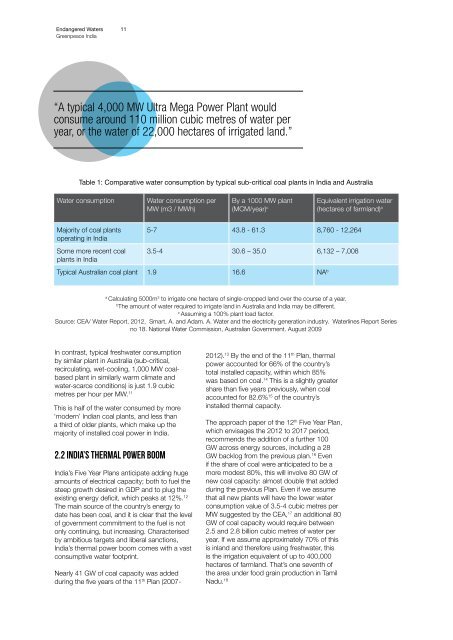Endangered Waters - Greenpeace
Endangered Waters - Greenpeace
Endangered Waters - Greenpeace
You also want an ePaper? Increase the reach of your titles
YUMPU automatically turns print PDFs into web optimized ePapers that Google loves.
<strong>Endangered</strong> <strong>Waters</strong><br />
<strong>Greenpeace</strong> India<br />
11<br />
“A typical 4,000 MW Ultra Mega Power Plant would<br />
consume around 110 million cubic metres of water per<br />
year, or the water of 22,000 hectares of irrigated land.”<br />
Table 1: Comparative water consumption by typical sub-critical coal plants in India and Australia<br />
Water consumption<br />
Water consumption per<br />
MW (m3 / MWh)<br />
By a 1000 MW plant<br />
(MCM/year) c<br />
Equivalent irrigation water<br />
(hectares of farmland) a<br />
Majority of coal plants<br />
operating in India<br />
Some more recent coal<br />
plants in India<br />
5-7 43.8 - 61.3 8,760 - 12,264<br />
3.5-4 30.6 – 35.0 6,132 – 7,008<br />
Typical Australian coal plant 1.9 16.6 NA b<br />
a<br />
Calculating 5000m 3 to irrigate one hectare of single-cropped land over the course of a year.<br />
b<br />
The amount of water required to irrigate land in Australia and India may be different.<br />
c<br />
Assuming a 100% plant load factor.<br />
Source: CEA/ Water Report, 2012, Smart, A. and Adam. A. Water and the electricity generation industry. Waterlines Report Series<br />
no 18. National Water Commission, Australian Government. August 2009<br />
In contrast, typical freshwater consumption<br />
by similar plant in Australia (sub-critical,<br />
recirculating, wet-cooling, 1,000 MW coalbased<br />
plant in similarly warm climate and<br />
water-scarce conditions) is just 1.9 cubic<br />
metres per hour per MW. 11<br />
This is half of the water consumed by more<br />
‘modern’ Indian coal plants, and less than<br />
a third of older plants, which make up the<br />
majority of installed coal power in India.<br />
2.2 India’s thermal power boom<br />
India’s Five Year Plans anticipate adding huge<br />
amounts of electrical capacity; both to fuel the<br />
steep growth desired in GDP and to plug the<br />
existing energy deficit, which peaks at 12%. 12<br />
The main source of the country’s energy to<br />
date has been coal, and it is clear that the level<br />
of government commitment to the fuel is not<br />
only continuing, but increasing. Characterised<br />
by ambitious targets and liberal sanctions,<br />
India’s thermal power boom comes with a vast<br />
consumptive water footprint.<br />
Nearly 41 GW of coal capacity was added<br />
during the five years of the 11 th Plan (2007-<br />
2012). 13 By the end of the 11 th Plan, thermal<br />
power accounted for 66% of the country’s<br />
total installed capacity, within which 85%<br />
was based on coal. 14 This is a slightly greater<br />
share than five years previously, when coal<br />
accounted for 82.6% 15 of the country’s<br />
installed thermal capacity.<br />
The approach paper of the 12 th Five Year Plan,<br />
which envisages the 2012 to 2017 period,<br />
recommends the addition of a further 100<br />
GW across energy sources, including a 28<br />
GW backlog from the previous plan. 16 Even<br />
if the share of coal were anticipated to be a<br />
more modest 80%, this will involve 80 GW of<br />
new coal capacity: almost double that added<br />
during the previous Plan. Even if we assume<br />
that all new plants will have the lower water<br />
consumption value of 3.5-4 cubic metres per<br />
MW suggested by the CEA, 17 an additional 80<br />
GW of coal capacity would require between<br />
2.5 and 2.8 billion cubic metres of water per<br />
year. If we assume approximately 70% of this<br />
is inland and therefore using freshwater, this<br />
is the irrigation equivalent of up to 400,000<br />
hectares of farmland. That’s one seventh of<br />
the area under food grain production in Tamil<br />
Nadu. 18

















